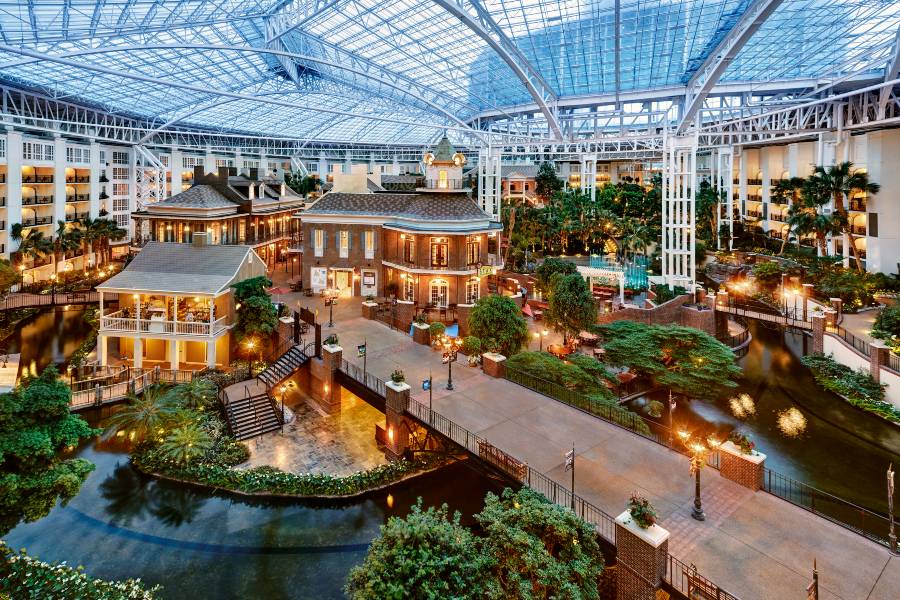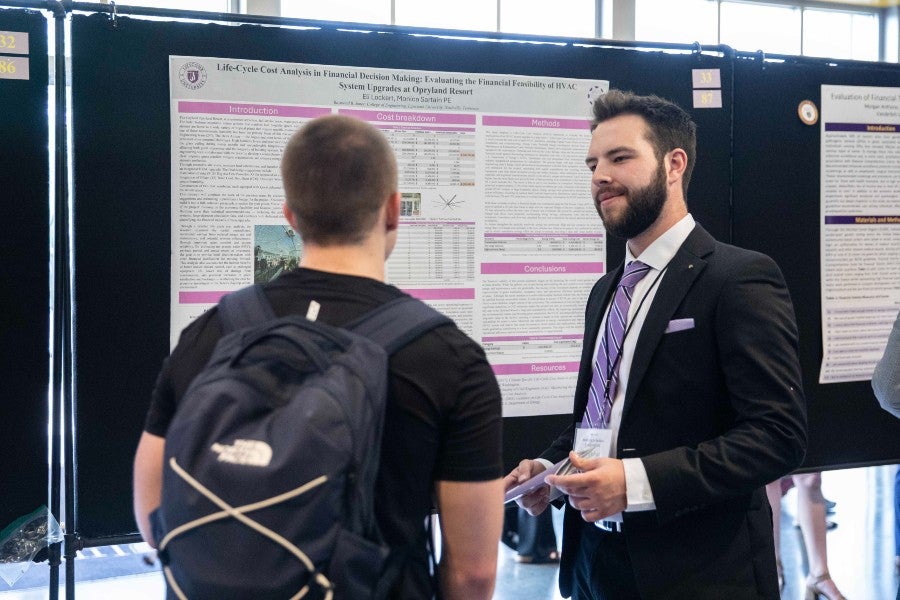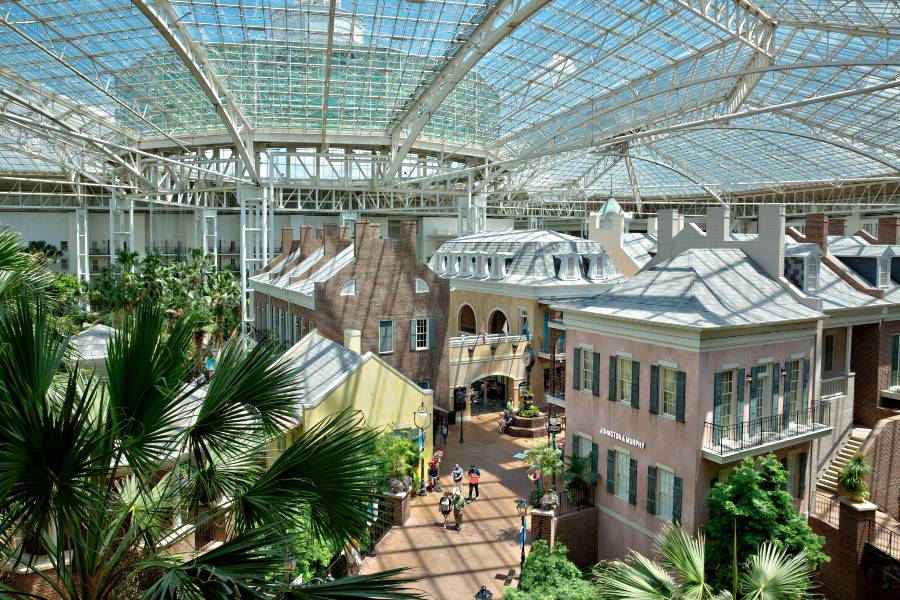Students help Opryland address the challenges of success
Engineering students face traffic and temperature control issues head-on to make recommendations to Nashville’s world-famous resort.
By Janel Shoun-Smith | 615-966-7078 |

The Delta Atrium at the Gaylord Opryland Resort & Convention Center. © 2025 Gaylord Opryland
With great success, comes huge crowds of people which sometimes causes unexpected challenges that can only be solved by one group: engineers.
For the past two years, Lipscomb’s civil engineering students have partnered with the engineering department at Nashville’s iconic Gaylord Opryland Resort & Convention Center on a pair of projects to provide fresh ideas to address the tough issues that come with such success.
The nationally known hotel features expansive indoor atriums that are home to a wide variety of tropical plants requiring specific conditions to thrive. One of those requirements, humidity, has posed ongoing challenges.
In addition, the popularity of the hotel, especially during Christmas when its grounds and atriums play host to various holiday attractions and décor, creates thorny traffic problems that stretch onto the surrounding roadways.
In 2024, a group of senior engineers, Alyssa Hampton (BS ’24), Tracie Santiago (BS ’24), Saly Alammuri (BS ’24), Taylor Crawford (BS ’24), Jonathan Ochoa-Guzman (BS ’24), Gracie Hall (BS ’24), Daniel Harvey (BS ’24) and Tamyra Kirby (BS ’24), analyzed the humidity situation as their capstone senior project.
In 2025, one senior student, Eli Lockert (BS ’25), followed up with a financial analysis of the solutions to the humidity problem, and another student Kennedy Case (BS ’25) focused on potential options to mitigate traffic congestion issues.
We benefit from fresh, innovative solutions to our technical challenges with exposure to the latest advancements in engineering and technology. The collaboration has fostered a rewarding and energizing exchange of ideas and perspectives. — Mark Petty, Gaylord Opryland Senior Director of Engineering
High humidity levels and poor air circulation within The Delta Atrium, a go-to section of the hotel for visitors, have led to condensation on the glass ceilings during winter months and uncomfortable temperature differences in pockets throughout the atrium.
Working with Gaylord Opryland Senior Director of Engineering Mark Petty, the 2024 students toured the hotel site, collected Gaylord’s data on the issues, took their own measurements and used moisture load calculations to take into account the amount of moisture humans themselves add to the equation, said Monica Sartain, P.E., assistant professor in the civil and environmental engineering department.
The students presented their suggestions to the Opryland engineering team in 2024, recommending removing moisture from the atrium through an integrated HVAC upgrade by installing 15 desiccant wheels into the atrium’s existing rooftop air handling units and nine new 24-inch fans for improved air circulation.
In addition they recommended constructing two new vestibules equipped with dehumidifiers between the hotel’s Delta atrium and the adjacent Soundwaves water park, which must be kept very humid, and the Cascades atrium area.

Engineering student Eli Lockert presenting his financial analysis at Lipscomb's Student Scholars Symposium.
This past spring, Lockert conducted a detailed life cycle cost analysis of the new equipment recommended. Taking into account the initial capital purchase of the upgrades, annual maintenance costs, reductions in current maintenance and energy costs, reduction in CO2 emissions and an expected revenue boost based on higher occupancy rates, improved guest satisfaction and greater appeal for hosting events in the atrium, Lockert found that the HVAC upgrades would “make this project not only an economically sound decision but also a key step in the Opryland resort’s long-term sustainability efforts."
“By improving operational efficiency, reducing the environmental impact and boosting guest satisfaction, the HVAC and dehumidification upgrades will deliver long-term value to the facility, ensuring it remains a leader in both operational excellence and environmental stewardship for years to come,” wrote Lockert.
Finally, Case worked to identify strategies to alleviate traffic congestion in the resort area, which sees more than one million visitors during the holiday season each year. Case did a literature review on traffic management innovations focusing on ride-pooling, visitor behavior and smart parking systems, and went on-site at the resort to analyze the flow of traffic, utilization of parking and visitor behavior in real-time.
Observing Opryland Drive at peak key congestion points, Case found that the vast majority of traffic is made up of personal vehicles for individuals and families, most of whom are not headed to the hotel’s registration desk. She recommended encouraging the use of ridesharing or shuttle services, implementing dynamic pricing and using digital signage that provides real-time traffic information to drivers to reduce congestion levels.

The Delta Atrium at the Gaylord Opryland Resort & Convention Center. © 2025 Gaylord Opryland
“The collaboration with Opryland is a great opportunity for our students to learn how to work through design challenges with an actual client,” said Sartain. “The people at Opryland have gone out of their way to provide data, drawings and site visits so the students gain a better understanding of their operation.
“At the end of the project they also invite the students to provide a presentation of their findings to hotel managers and the Engineering Department, providing a time for the students to highlight their work and defend their findings,” she said.
“Our partnership with Lipscomb University has been incredibly valuable for both Gaylord Opryland and the participating senior students,” said Petty. “The students gain hands-on experience applying their academic knowledge in a dynamic and challenging real-world environment. In turn, we benefit from fresh, innovative solutions to our technical challenges with exposure to the latest advancements in engineering and technology. The collaboration has fostered a rewarding and energizing exchange of ideas and perspectives.”

Student Kennedy Case (left) worked to identify strategies to alleviate traffic congestion in the Opryland resort area.